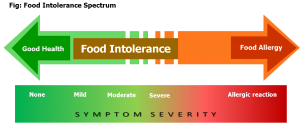Food intolerance is relatively a new concept, and can be difficult to understand. Even most doctors have a poor understanding of it, particularly when there is a mixture of signs and symptoms that do not belong in the same disease group or there is no pathological explanation.
Common complaints such as headaches, bloating and tiredness after eating may be due to food intolerance. Importantly, this is different from food allergy which occurs as an immune reaction that releases the chemical histamine into the tissues, causing itchy rashes, stomach upsets, cough, wheeze and more severe life threatening anaphylaxis symptoms. At times symptoms of food intolerance can be similar to food allergy reactions, which can cause confusion. A food allergy will normally show up on allergy tests, however food intolerance may not. For this reason having food allergy tests do not always give the answers that we seek. One way to look at this is as a spectrum, where food allergy is at the severe end whilst food intolerance is found in the middle with good health at the other end.
In food intolerance substances in food can increase the frequency or severity of existing symptoms or cause new symptoms. This can depend on the amount of the offending food that is eaten. Small amounts may not cause any problems, whilst larger amounts will give rise to troublesome symptoms. The reaction time to an intolerant food varies and since we eat and drink many times a day, sometimes we may get a confused picture of the problem.
Food intolerance adverse reactions may include;
- General feeling unwell after eating e.g. bloating, heartburn and indigestion.
- Malaise, tiredness and feeling sleepy.
- Headaches, arthritis and eczema.
- Flushing, nausea and bloating.
- Diarrhoea and/or constipation.
- Aversion for certain foods where the person not only dislikes the food, but also reacts at the sight or smell of the food. In some this is triggered by emotional association with the food.
- Underlying anxiety can cause hyperventilation and considerable distress resulting in dizziness, tight chest, blurred vision, unusual body sensations or numbness.
- Gut upset, weight loss and anaemia.
Food intolerance causes include;
- Enzyme deficiency e.g. lactose intolerance.
- Food poisoning: A history of gastroenteritis or food poisoning can leave longer term digestive problems.
- Food additives: In sensitive people additives used for food preservation, consistency, colour and taste can trigger symptoms e.g. sulphites used to preserve dried fruits and canned goods, and some sweeteners can cause headaches.
- Certain conditions e.g. irritable bowel syndrome increases the risk of food intolerance.
- Celiac disease is triggered by eating gluten (found in wheat and other grains). There are some features of food allergy, but symptoms are limited to the digestive system.
- Continual or recurring stress, or psychological factors.
Diagnosis of food intolerance is based mainly on a detailed history, response to treatment and a continual process of dietary review over a period of time. As explained earlier allergy tests are of little value. The history will help to identify the offending foods or other factors that aggravate symptoms. Often people are able to recognise some of the foods themselves, or by a process of trial and error i.e. by temporarily excluding a suspect food from the diet. Using a food diary to keep a record of what is eaten and any symptoms that may develop during that time is very helpful. Another way is to avoid all suspect foods from the diet until there are no symptoms, followed by a gradual reintroduction of one type of food at a time to see which cause symptoms. In both cases there is a risk of having an inadequate diet, therefore always seek advice from an experienced and knowledgeable medical or health practitioner.
In my experience the use of a combined integrated approach to treat food intolerance offers excellent results. It is important to remember that every treatment plan is individualised to the person, as each person is unique and different in the problems they experience. Additionally, they also vary in their response to treatments. In general following a detailed history every treatment will start with a dietary review, followed by reducing or avoiding the intake of problem foods. Learning to read ingredient lists of processed foods is key to ensuring that the appropriate foods are avoided. Often I find that there is a poor understanding of processed foods and what they may contain. In many cases because of deterioration in health there is food hypersensitivity, where people start to react to non-problem foods and present at my clinic with a very confused picture. Regular acupuncture treatments aimed at restoring healthy body function, by enhancing blood circulation, immune function and flow of Qi (energy), will help calm the body and reduce reactivity to foods. It also eases abdominal cramps, nausea, stress and anxiety. Where necessary multivitamins and supplements are advised to help reduce nutrient deficiencies, alleviate symptoms and in the long-term promote healing of the gut.
References:
- Food intolerance (2014). Australasian Society of Clinical Immunology and Allergy (ASCIA) http://www.allergy.org.au/patients/food-other-adverse-reactions/food-intolerance
- Li JTC, (2016). What’s the difference between a food intolerance and food allergy? http://www.mayoclinic.org/diseases-conditions/food-allergy/expert-answers/food-allergy/faq-20058538

